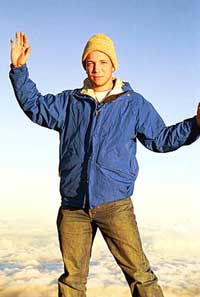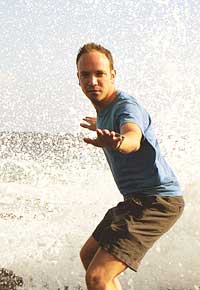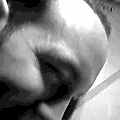David Kestenbaum
David Kestenbaum had planned on becoming a physicist, but a funny thing happened on the way to his Ph.D. His girlfriend dumped him. That was in 1994, and although he finished the degree two years later, today, at age 39, he is a science reporter for National Public Radio in Washington, D.C.
As he explains it, the young lady broke off the relationship with him to date a fellow who was also a writer. “It was one of those weird quirks of fate that got me thinking about science writing,” David recalls. “I thought of journalism as an option. She was writing, this other guy was writing, other people I knew were writing, so it seemed that I should try,” he says. “I wasn't on a campaign to get her back or anything, but I did think, why can't I do something creative in another way?”

David Kestenbaum on top of the world.
Born in 1969 in Providence, Rhode Island, David grew up in Glenside, Pennsylvania, a suburb of Philadelphia. His mother works for a bank, although she majored in music in college, and his father is an editor for the Philadelphia Inquirer newspaper. He has a younger sister named Heidi
David was always interested in physics and math. “I loved the idea that equations had something to do with the real world,” David says. “I remember in tenth grade learning about gravity and doing an experiment dropping weights. I tried to figure out 'g' by myself,” referring to the magnitude of the constant acceleration due to gravity. “I wrote a computer program to plot it.”
Working out math equations had a hypnotic effect on him. “Doing math was like being in a trance, it was incredibly peaceful and relaxing,” he says.
David also taught himself to write computer programs, even writing programs for Pac-Man, a popular video game in the 1980s, on an ancient Apple II computer that had no graphics. He recalls, “You had to use the 'greater than' or 'less than' signs if the Pac-Man was going side to side, a caret if it was going down, and a 'V' if it was going up. That was in high school probably in 1985.”
While a senior in high school, through the University of Pennsylvania's physics department David got a job writing computer programs for the Collider Detector at Fermilab (CDF). Fermilab, or more properly the Fermi National Accelerator Laboratory, is located in Batavia, Illinois and is home to the most powerful particle accelerator in the world. He went to Fermilab to write programs used to monitor the voltages, currents and temperatures of the detector system. “People would call me in the middle of the night and say you have to come in,” he recalls. “But I didn't know what I was working on. I didn't know a quark from a hole in the ground.”
As it turned out, David's connection to Fermilab was to last throughout his physics undergraduate and graduate careers. The research done at CDF looking for the top quark was to be the basis of his doctoral thesis.
After graduating high school in 1987, David went to Yale University and majored in physics and continued to work at Fermilab in the summers. He earned his bachelor of science degree in 1991. Though he really enjoyed working at CDF, he was still unclear about what career path he wanted to take after he graduated. “I went to Fermilab in several of the summers, working on CDF doing different kinds of stuff,” he says. “I was sort of at loose ends when I graduated. I wasn't quite sure what was next. I was not saying the whole time, 'I'm definitely going into physics.'”
Later in 1991, David entered Harvard University's graduate physics program. “I went to Harvard, but I was afraid of Harvard. You know, you're always afraid you are an impostor. You are always afraid that people will discover that you don't entirely understand what you're doing,” he says. But things turned out well because of his adviser, Melissa Franklin, a particle physicist who was searching for the top quark. By 1996, he had finished his doctoral thesis.
“I was lucky. The experiment was already up and running. I wrote my thesis, sort of repeated the analysis, me and a lot of other people, like 400 others,” David says. “I happened to be there just at the time when we discovered the top quark. We had a pretty good idea it was there. The top quark is part of the Standard Model.”
But it was during this time that David's girlfriend dumped him for the writer, a fact that sparked his interest in also writing and thinking about journalism. His first free-lance experience was with the Chicago Reader, a weekly, alternative newspaper in Chicago, where he was now living. “I wrote about the science of traffic jams and I wrote a piece about this unusual physicist who gave a talk at Fermilab about how he had derived the existence of God.”
[The speaker was Dr. Frank J. Tipler, professor of mathematics at Tulane University, and author of a number of books and articles, including The Physics of Immortality, The Anthropic Cosmological Principle, and God in the Equations.]
Having completed his Ph.D. in physics, David decided not to do postdoctoral research. “I decided I needed to take some time off and see if physics is what I really wanted to do,” he recalls. “Physics made me happy, but I felt like I didn't know what else was out there.”
David continued to freelance, writing for small trade magazines and for the British magazine New Scientist. He decided that getting a formal degree in journalism was the wrong way to go. “My ex-girlfriend didn't go to journalism school. There was a sense that if you were trained formally, it took some of the creativity away,” he says. His advice to other would-be journalists is straightforward. “Look, if you want to write, just write, don't tread water in school for another few years. Just write. You learn everything by doing.”

A major break came in 1997 when he wrote a freelance piece on particle physics for The New York Times. David later got into the American Association for the Advancement of Science's Mass Media Fellowship program. The fellowship was actually paid for by the American Physical Society. This program brings aspiring science journalists into real-world settings. In David's case, he ended up at WOSU, a radio station in Columbus, Ohio in the summer of 1997.
Thereafter, Science magazine, which is published by the American Association for the Advancement of Science (AAAS), offered him a six-month internship in Washington, D.C. David took the offer but on the condition that he be allowed to pursue other goals, chief of which eventually working at National Public Radio, also in Washington. “I requested that I do it only four days a week. On the fifth day, I hoped to either keep freelancing or work for NPR (National Public Radio),” he says. “I moved to Washington. I left all my things in Chicago. I took just a fork and a spoon and some clothes.”
Following the successful six-month fellowship, during which David wrote a lot, the magazine offered him a full-time job. But he still wanted to work for NPR and in 1998, he rode his bike the short distance from the AAAS building to the NPR building in downtown Washington and said point-blank to one of the editors, “Let's talk about the ways you can hire me.” The editor's reply was, “There aren't any,” but David persisted. “Eventually, they let me come and work one day a week... And then hired me in March 1999.”
David says he much prefers the sort of radio journalism he practices to print journalism, which often doesn't hold the reader's attention. “I prefer radio journalism. Radio is really fun. I like crafting a piece. It's like putting a song together,” he says. “You have more space in print, but I think what happens in a lot of newspaper stories is that people read the first three paragraphs... and then they bail. When you are talking on the radio, you are the only thing that NPR is putting on at that moment. It's not like there are ten other things they can tune in.”
But he says that radio journalism requires that a story hold together. Fortunately for him, David says, “I like story telling.” Because radio depends on the spoken word, David says it is imperative for a radio science reporter to have guests who will “talk clearly and coherently... Try to get a scientist to talk for 20 seconds without using jargon. It's very difficult.”
He contrasts print with radio journalism by the fact that in print, the reader can re-read a particularly difficult sentence over and over. In radio, everything must make sense and there is no time to go back. “You have to keep people with you as it unfolds,” he says.
David plans to stay at NPR for the time being. He enjoys being able to bike to work and being able to dress casually at the office. He lives in the Mount Pleasant section of Washington.












